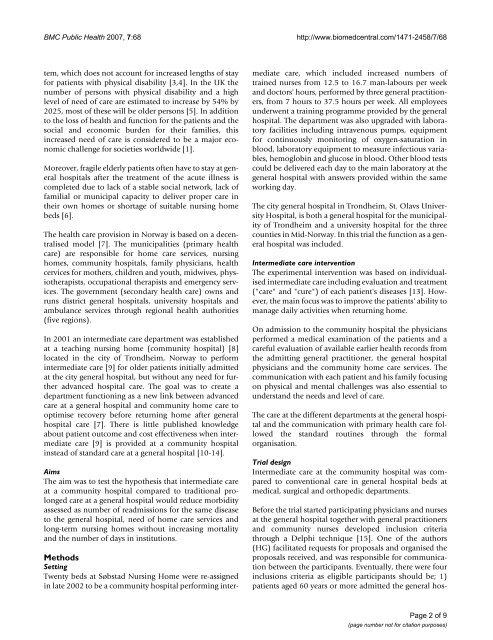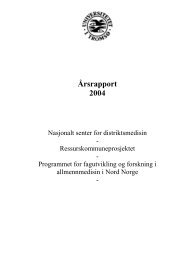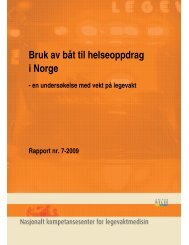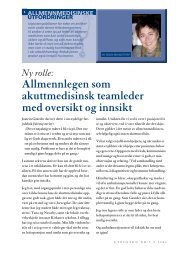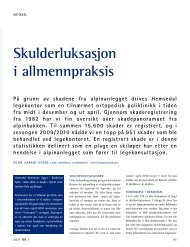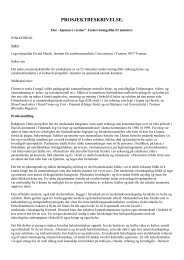Helge Garåsen The Trondheim Model - NSDM
Helge Garåsen The Trondheim Model - NSDM
Helge Garåsen The Trondheim Model - NSDM
Create successful ePaper yourself
Turn your PDF publications into a flip-book with our unique Google optimized e-Paper software.
BMC Public Health 2007, 7:68<br />
http://www.biomedcentral.com/1471-2458/7/68<br />
tem, which does not account for increased lengths of stay<br />
for patients with physical disability [3,4]. In the UK the<br />
number of persons with physical disability and a high<br />
level of need of care are estimated to increase by 54% by<br />
2025, most of these will be older persons [5]. In addition<br />
to the loss of health and function for the patients and the<br />
social and economic burden for their families, this<br />
increased need of care is considered to be a major economic<br />
challenge for societies worldwide [1].<br />
Moreover, fragile elderly patients often have to stay at general<br />
hospitals after the treatment of the acute illness is<br />
completed due to lack of a stable social network, lack of<br />
familial or municipal capacity to deliver proper care in<br />
their own homes or shortage of suitable nursing home<br />
beds [6].<br />
<strong>The</strong> health care provision in Norway is based on a decentralised<br />
model [7]. <strong>The</strong> municipalities (primary health<br />
care) are responsible for home care services, nursing<br />
homes, community hospitals, family physicians, health<br />
cervices for mothers, children and youth, midwives, physiotherapists,<br />
occupational therapists and emergency services.<br />
<strong>The</strong> government (secondary health care) owns and<br />
runs district general hospitals, university hospitals and<br />
ambulance services through regional health authorities<br />
(five regions).<br />
In 2001 an intermediate care department was established<br />
at a teaching nursing home (community hospital) [8]<br />
located in the city of <strong>Trondheim</strong>, Norway to perform<br />
intermediate care [9] for older patients initially admitted<br />
at the city general hospital, but without any need for further<br />
advanced hospital care. <strong>The</strong> goal was to create a<br />
department functioning as a new link between advanced<br />
care at a general hospital and community home care to<br />
optimise recovery before returning home after general<br />
hospital care [7]. <strong>The</strong>re is little published knowledge<br />
about patient outcome and cost effectiveness when intermediate<br />
care [9] is provided at a community hospital<br />
instead of standard care at a general hospital [10-14].<br />
Aims<br />
<strong>The</strong> aim was to test the hypothesis that intermediate care<br />
at a community hospital compared to traditional prolonged<br />
care at a general hospital would reduce morbidity<br />
assessed as number of readmissions for the same disease<br />
to the general hospital, need of home care services and<br />
long-term nursing homes without increasing mortality<br />
and the number of days in institutions.<br />
Methods<br />
Setting<br />
Twenty beds at Søbstad Nursing Home were re-assigned<br />
in late 2002 to be a community hospital performing intermediate<br />
care, which included increased numbers of<br />
trained nurses from 12.5 to 16.7 man-labours per week<br />
and doctors' hours, performed by three general practitioners,<br />
from 7 hours to 37.5 hours per week. All employees<br />
underwent a training programme provided by the general<br />
hospital. <strong>The</strong> department was also upgraded with laboratory<br />
facilities including intravenous pumps, equipment<br />
for continuously monitoring of oxygen-saturation in<br />
blood, laboratory equipment to measure infectious variables,<br />
hemoglobin and glucose in blood. Other blood tests<br />
could be delivered each day to the main laboratory at the<br />
general hospital with answers provided within the same<br />
working day.<br />
<strong>The</strong> city general hospital in <strong>Trondheim</strong>, St. Olavs University<br />
Hospital, is both a general hospital for the municipality<br />
of <strong>Trondheim</strong> and a university hospital for the three<br />
counties in Mid-Norway. In this trial the function as a general<br />
hospital was included.<br />
Intermediate care intervention<br />
<strong>The</strong> experimental intervention was based on individualised<br />
intermediate care including evaluation and treatment<br />
("care" and "cure") of each patient's diseases [13]. However,<br />
the main focus was to improve the patients' ability to<br />
manage daily activities when returning home.<br />
On admission to the community hospital the physicians<br />
performed a medical examination of the patients and a<br />
careful evaluation of available earlier health records from<br />
the admitting general practitioner, the general hospital<br />
physicians and the community home care services. <strong>The</strong><br />
communication with each patient and his family focusing<br />
on physical and mental challenges was also essential to<br />
understand the needs and level of care.<br />
<strong>The</strong> care at the different departments at the general hospital<br />
and the communication with primary health care followed<br />
the standard routines through the formal<br />
organisation.<br />
Trial design<br />
Intermediate care at the community hospital was compared<br />
to conventional care in general hospital beds at<br />
medical, surgical and orthopedic departments.<br />
Before the trial started participating physicians and nurses<br />
at the general hospital together with general practitioners<br />
and community nurses developed inclusion criteria<br />
through a Delphi technique [15]. One of the authors<br />
(HG) facilitated requests for proposals and organised the<br />
proposals received, and was responsible for communication<br />
between the participants. Eventually, there were four<br />
inclusions criteria as eligible participants should be; 1)<br />
patients aged 60 years or more admitted the general hos-<br />
Page 2 of 9<br />
(page number not for citation purposes)


